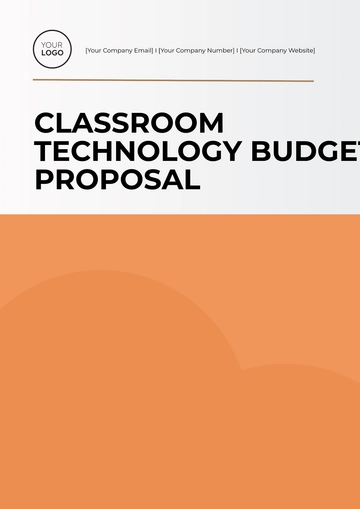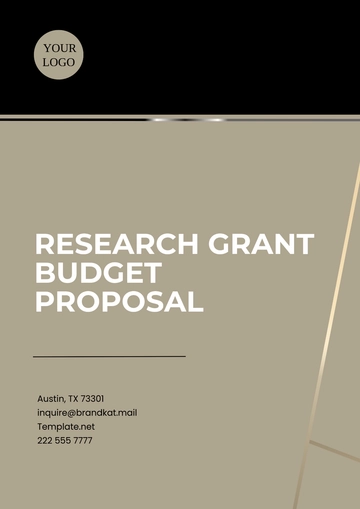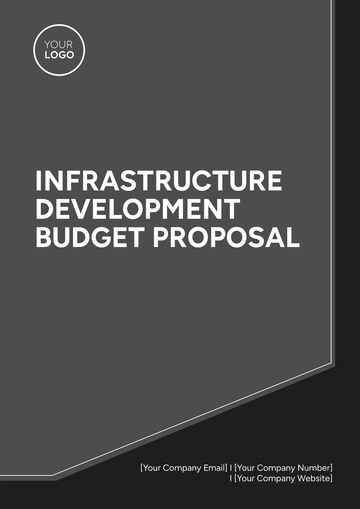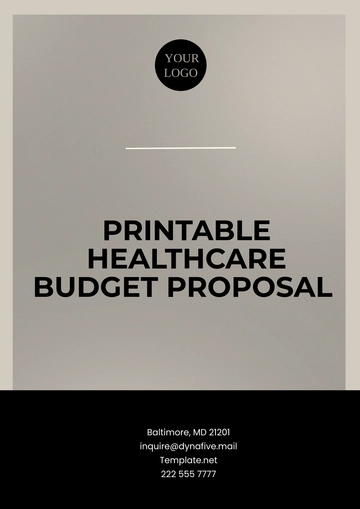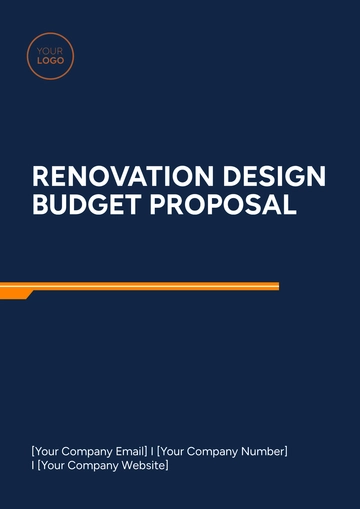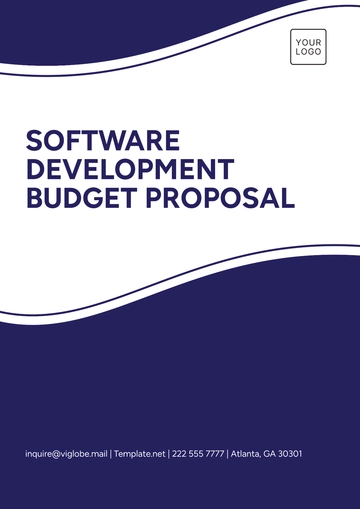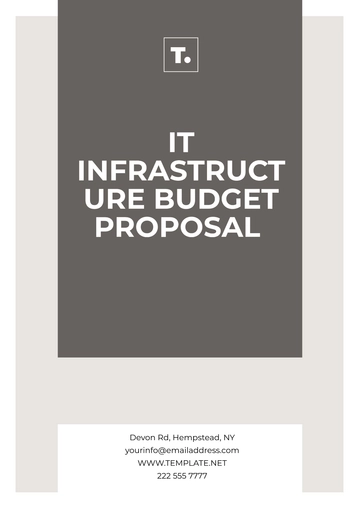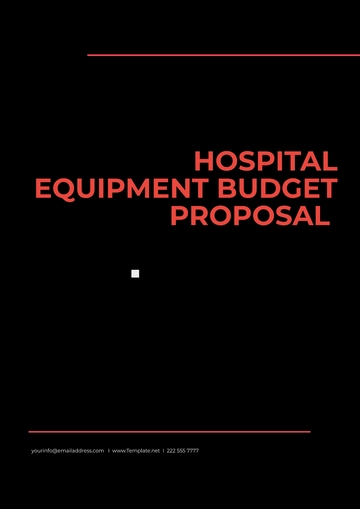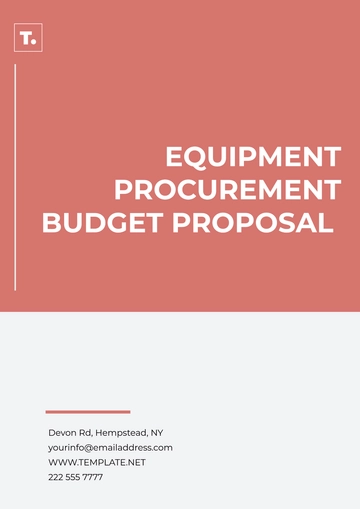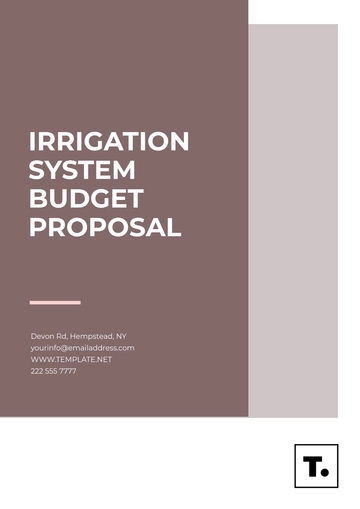Free Finance Capital Budget Proposal

I. Executive Summary
Overview
This capital budget proposal represents a strategic roadmap for [Your Company Name]'s investments in the upcoming fiscal year. It carefully outlines our plan to allocate significant resources toward pivotal projects that are expected to yield considerable returns. These initiatives have been meticulously selected not only for their immediate benefits but also for their alignment with our broader long-term objectives. The proposal details investments in cutting-edge technology, infrastructure enhancements, and market expansion efforts, all aimed at fortifying [Your Company Name]'s position in the industry.
Objectives and Impact
The cornerstone of this proposal is to channel investments into areas that will catalyze operational modernization and productivity enhancements across [Your Company Name]. We anticipate these investments will significantly streamline our processes, reduce operational costs, and elevate our product and service offerings. The expected impact is multifaceted: we project a marked increase in our revenue streams over the next few years, driven by both efficiency gains and market expansion. Furthermore, these strategic investments are poised to solidify our market position, ensuring [Your Company Name] remains competitive and continues to grow in an ever-evolving business landscape.
II. Project Description and Justification
This section of the proposal meticulously details the specific projects [Your Company Name] seeks to invest in, along with a rationale for each. It underscores how these investments are critical for achieving our strategic objectives and strengthening our market position.
A. Project Details
Our proposal earmarks substantial investments in three key areas. First, we plan to acquire advanced manufacturing equipment to significantly enhance our production capabilities. This state-of-the-art machinery is expected to automate and streamline our manufacturing processes, leading to higher output with reduced operational costs.
Secondly, upgrading our IT infrastructure is pivotal. This includes investing in robust cybersecurity measures and modernizing our IT systems to support our growing digital needs.
Lastly, we aim to expand into new markets. This involves researching and entering new geographic territories, adapting our marketing strategies to cater to diverse customer bases, and establishing a foothold in these regions.
B. Justification
The justification for these investments is clear and compelling. The new manufacturing equipment is projected to increase our production efficiency by 30%, directly impacting our bottom line by reducing costs and enabling us to meet increased customer demand more effectively. Upgrading our IT infrastructure is not just a necessity but a strategic move to safeguard our digital assets, enhance operational efficiency, and support our workforce.
As for market expansion, it's an ambitious strategy aimed at increasing our market share by 15% in new regions within the next two years. This expansion is critical for diversifying our revenue streams and mitigating risks associated with over-reliance on existing markets. Each of these projects is strategically chosen to propel [Your Company Name] towards sustained growth and a stronger competitive edge.
III. Cost Analysis and Funding Sources
In this section, we provide a detailed breakdown of the costs associated with each project in [Your Company Name]'s capital budget proposal, along with a comprehensive plan for funding these investments. Our approach balances various funding sources to maintain financial stability while pursuing these strategic initiatives.
A. Cost Breakdown
Project | Estimated Cost | Description |
|---|---|---|
Manufacturing Equipment | $2 million | Includes purchase and installation of advanced manufacturing machinery |
IT Infrastructure | $1.5 million | Covers costs for upgrading systems, cybersecurity enhancements, and software |
Market Expansion | $2.5 million | Encompasses market research, marketing campaigns, and initial operational costs in new regions |
B. Funding Sources
The projects will be funded through a combination of retained earnings, long-term loans, and potential equity financing, ensuring a balanced approach to capital sourcing and maintaining financial stability.
Source | Amount | Purpose |
|---|---|---|
Retained Earnings | $2 million | To partly finance manufacturing equipment and IT infrastructure upgrades |
Long-term Loans | $3 million | Aimed at covering a significant portion of the market expansion and equipment costs |
Equity Financing | $1 million | To supplement funding, particularly for IT infrastructure and additional market research |
IV. Risk Assessment and Mitigation
This section outlines the risk assessment and mitigation strategies for [Your Company Name]'s capital budget proposal. We identify key risks associated with each project and propose strategic measures to effectively manage and mitigate these risks, ensuring project success and financial stability.
A. Risk Analysis
Identified risks include potential delays in equipment installation, unforeseen IT integration challenges, and market entry barriers.
Project | Risk Identified | Potential Impact |
|---|---|---|
Manufacturing Equipment | Delays in Equipment Installation | Could lead to production downtime and revenue loss |
IT Infrastructure | IT Integration Challenges | Possible disruptions in business operations |
Market Expansion | Market Entry Barriers | Risk of underperformance in new markets due to competitive or regulatory hurdles |
B. Mitigation Strategies
To mitigate these risks, we propose contingency plans including vendor agreements with penalty clauses, engaging IT consultants, and conducting extensive market research before entry.
Risk | Mitigation Strategy | Implementation Plan |
|---|---|---|
Equipment Installation Delays | Vendor Agreements with Penalty Clauses | Secure contracts with clear timelines and penalties for delays to protect against installation setbacks |
IT Integration Challenges | Engaging Specialist IT Consultants | Hire experienced IT consultants for smooth integration and to troubleshoot potential issues |
Market Entry Barriers | Extensive Market Research | Conduct thorough market analysis to understand local market dynamics, competitive landscape, and regulatory requirements before entry |
V. Return on Investment and Financial Projections
In this section, we present an analysis of the expected Return on Investment (ROI) for each project and the overall financial projections for [Your Company Name]. These insights are crucial for understanding the long-term financial benefits of the proposed capital investments.
A. ROI
The investment in advanced manufacturing equipment is projected to significantly enhance production efficiency, resulting in an estimated ROI of 20% within three years. This is primarily due to increased output and reduced labor costs. The IT infrastructure upgrade, crucial for operational efficiency and cybersecurity, is expected to reduce overall operational costs by 15%, contributing directly to the bottom line.
Furthermore, our market expansion initiative, involving entry into new regions, is anticipated to yield a substantial ROI of 25% over the next five years, driven by increased sales volumes and market share.
B. Financial Projections
With these strategic investments, [Your Company Name] is poised to see a considerable improvement in financial performance. We project that the combined impact of enhancing manufacturing processes, upgrading IT systems, and expanding into new markets will boost our annual revenue by approximately 20% over the next five years.
Additionally, these investments are expected to enhance our profit margins by 10% during the same period, reflecting the efficiency gains and cost savings from the new equipment and IT upgrades, as well as the revenue growth from expanded market presence. These projections underscore the strategic value of the proposed investments, setting [Your Company Name] on a trajectory for sustained financial growth and success.
VI. Sustainability and Environmental Impact
In line with [Your Company Name]'s commitment to sustainability, this section evaluates the environmental impact of each proposed project. For instance, the manufacturing equipment chosen not only increases efficiency but also reduces energy consumption, aligning with our goal to minimize our carbon footprint. The IT infrastructure upgrades include implementing energy-efficient systems and servers, further demonstrating our dedication to eco-friendly practices.
Our market expansion plan also incorporates sustainable approaches, focusing on entering markets with environmentally conscious products and services. This aligns with [Your Company Name]'s overarching sustainability objectives, reinforcing our position as an environmentally responsible organization. By integrating these considerations into our capital budgeting, we ensure that our financial decisions contribute positively to our long-term sustainability targets.
VII. Compliance and Regulatory Considerations
This section outlines the compliance and regulatory aspects associated with each investment. The new manufacturing equipment will adhere to all industry and environmental regulations, ensuring compliance with safety and emission standards. Similarly, the IT infrastructure upgrade will be executed in accordance with data protection and cybersecurity regulations, crucial for maintaining our integrity in data management and security.
For market expansion, we have a dedicated team to monitor and ensure adherence to regional and international trade laws and regulations. This proactive approach to compliance safeguards [Your Company Name] from potential legal and financial risks associated with non-compliance, ensuring smooth operation across different markets. This attention to compliance is a testament to [Your Company Name]'s commitment to operating ethically and responsibly in all aspects of our business
VIII. Stakeholder Impact and Engagement
This section assesses how the proposed capital investments will impact various stakeholders of [Your Company Name], including employees, customers, suppliers, and investors. For instance, the investment in manufacturing equipment is expected to enhance production efficiency, which may lead to workforce upskilling and potentially new employment opportunities. For customers, the investment signifies an improvement in product quality and service delivery. Suppliers may experience increased demand, while investors can anticipate enhanced company value and potential dividend growth.
We also outline strategies for engaging with these stakeholders throughout the project lifecycle. This includes regular updates to investors on project progress and returns, feedback mechanisms for customers, and training programs for employees to adapt to new technologies. Engaging suppliers in the planning process ensures a smooth supply chain operation, particularly during the market expansion phase. These engagement efforts underscore our commitment to maintaining positive and transparent relationships with all stakeholders.
IX. Project Implementation and Monitoring
Detailed here is the step-by-step plan for executing each capital project. The plan includes timelines, key milestones, resource allocation, and responsibilities assigned to various teams and departments. For instance, the IT infrastructure upgrade will be implemented in phases to minimize business disruption, while the market expansion project includes a pilot phase before full-scale implementation.
To ensure the successful execution of these projects, we establish a monitoring framework with clear metrics for performance evaluation. Regular reports will be generated to track progress against the set milestones and budget allocations. Any deviations from the plan will be promptly addressed through corrective measures. This section also outlines the communication plan for keeping management and other relevant parties informed about the project's progress. Effective monitoring and transparent reporting are crucial for maintaining accountability and ensuring that the projects deliver the expected outcomes.
- 100% Customizable, free editor
- Access 1 Million+ Templates, photo’s & graphics
- Download or share as a template
- Click and replace photos, graphics, text, backgrounds
- Resize, crop, AI write & more
- Access advanced editor
Unlock financial success with Template.net's Finance Capital Budget Proposal. Impeccable, customizable detail in an editable format, designed for creating precise and impactful data representation. Better yet, the proposal is editable in our Ai Editor Tool. Compact, professional, and engaging - mastering the art of finance has never been more within your reach.
You may also like
- Business Proposal
- Research Proposal
- Proposal Request
- Project Proposal
- Grant Proposal
- Photography Proposal
- Job Proposal
- Budget Proposal
- Marketing Proposal
- Branding Proposal
- Advertising Proposal
- Sales Proposal
- Startup Proposal
- Event Proposal
- Creative Proposal
- Restaurant Proposal
- Blank Proposal
- One Page Proposal
- Proposal Report
- IT Proposal
- Non Profit Proposal
- Training Proposal
- Construction Proposal
- School Proposal
- Cleaning Proposal
- Contract Proposal
- HR Proposal
- Travel Agency Proposal
- Small Business Proposal
- Investment Proposal
- Bid Proposal
- Retail Business Proposal
- Sponsorship Proposal
- Academic Proposal
- Partnership Proposal
- Work Proposal
- Agency Proposal
- University Proposal
- Accounting Proposal
- Real Estate Proposal
- Hotel Proposal
- Product Proposal
- Advertising Agency Proposal
- Development Proposal
- Loan Proposal
- Website Proposal
- Nursing Home Proposal
- Financial Proposal
- Salon Proposal
- Freelancer Proposal
- Funding Proposal
- Work from Home Proposal
- Company Proposal
- Consulting Proposal
- Educational Proposal
- Construction Bid Proposal
- Interior Design Proposal
- New Product Proposal
- Sports Proposal
- Corporate Proposal
- Food Proposal
- Property Proposal
- Maintenance Proposal
- Purchase Proposal
- Rental Proposal
- Recruitment Proposal
- Social Media Proposal
- Travel Proposal
- Trip Proposal
- Software Proposal
- Conference Proposal
- Graphic Design Proposal
- Law Firm Proposal
- Medical Proposal
- Music Proposal
- Pricing Proposal
- SEO Proposal
- Strategy Proposal
- Technical Proposal
- Coaching Proposal
- Ecommerce Proposal
- Fundraising Proposal
- Landscaping Proposal
- Charity Proposal
- Contractor Proposal
- Exhibition Proposal
- Art Proposal
- Mobile Proposal
- Equipment Proposal
- Student Proposal
- Engineering Proposal
- Business Proposal






